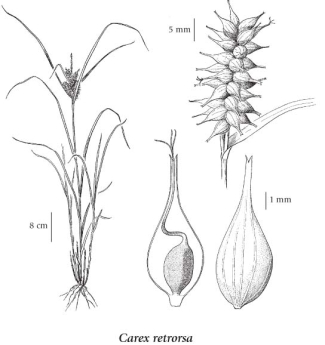Carex retrorsa Schwein.
long-bracted sedge (knotsheath sedge; retrorse sedge)
Cyperaceae (Sedge family)
Introduction to Vascular Plants
long-bracted sedge (knotsheath sedge; retrorse sedge)
Cyperaceae (Sedge family)
Introduction to Vascular Plants
Species Information
General:
Perennial, tufted herb from short-creeping rhizomes; stems 15-100 cm tall, triangular, smooth, shorter than the leaves.
Leaves:
Sheaths tight; ligules longer than wide; blades 4 to 8 per stem, flat, with whitish cross-walls, borne on the lower 1/2 of the stem, 3-10 mm wide, flat, the lower ones reduced, persistent.
Flowers:
Spikes 4 to 7, the terminal 2 or 3 linear, 1.5-5 cm long, long-stalked, with many male flowers, the lower 2 to 4 spikes cylindrical, 2.5-7.5 cm long, with female flowers, or some with male flowers above the female flowers, short-stalked, usually clustered together; bracts subtending the lowest spikes leaflike, sheathless, much longer than the inflorescence.
Fruits:
Perigynia elliptical, mostly reflexed, 7-10 mm long, 1.7-3 mm wide, yellowish-green to reddish-brown, somewhat inflated, smooth, shiny, strongly nerved, contracted into long beaks, the beaks 2-3.5 mm long, bidentate, with straight teeth; female scales lanceolate to egg-shaped, pointed, much narrower and shorter than the perigynia, yellowish- to reddish-brown, with 3-nerved, lighter greenish centres and narrow, translucent margins; stigmas 3; achenes 3-angled, 1.7-2.1 mm long.
Illustration

If more than one illustration is available for a species (e.g., separate illustrations were provided for two subspecies) then links to the separate images will be provided below. Note that individual subspecies or varietal illustrations are not always available.
Illustration Source: The Illustrated Flora of British Columbia
Ecology
Ecological Framework for Carex retrorsa
The table below shows the species-specific information calculated from
original data (BEC database) provided by the BC Ministry of Forests and Range.
(Updated August, 2013)
The table below shows the species-specific information calculated from
original data (BEC database) provided by the BC Ministry of Forests and Range.
(Updated August, 2013)
| Site Information |
Value / Class |
||
|
Avg |
Min |
Max |
|
| Elevation
(metres) |
485 | 38 | 1200 |
| Slope
Gradient (%) |
0 | 0 | 1 |
|
Aspect (degrees) |
115 | 97 | 135 |
| Soil
Moisture Regime (SMR) [0 - very xeric; 4 - mesic; 8 - hydric] |
6 | 5 | 8 |
| Modal
Nutrient Regime
Class |
D | ||
| #
of field plots species was recorded in: |
17 | ||
| Modal
BEC Zone Class |
SBS | ||
|
All BEC Zones (# of stations/zone) species was recorded in |
CDF(1), ICH(4), IDF(3), PP(1), SBS(5) | ||
|
Source:
Klinkenberg 2013
|
|||